Instructions for Side by Side Printing
- Print the notecards
- Fold each page in half along the solid vertical line
- Cut out the notecards by cutting along each horizontal dotted line
- Optional: Glue, tape or staple the ends of each notecard together
Pregnancy and Human development
front 1 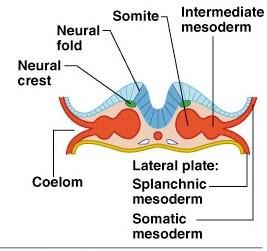 | back 1 somite |
front 2 implantation is usually completed after | back 2 the blastocyst is entirely surrounded by endometrium |
front 3 the chorionic membrane forms by which of the following layers in a developing embryo? | back 3 cytotrophoblast and syncitiotrophoblast both B and C |
front 4 which structure represents the remnant of the right to left atrial fetal shunt | back 4 fossa ovalis |
front 5 which structure below is formed from endodermal tissue | back 5 esophagus |
front 6 which structure below is formed from ectodermal tissues | back 6 brain |
front 7 raised edged dorsal groove on early embryonic disc that establishes the longitudinal axis of the embryo is | back 7 primitive streak |
front 8 which of the following is not a function of the placenta | back 8 urine formation |
front 9 embryonic period from 2 to ___ weeks | back 9 8 weeks |
front 10 the process which transforms the embryo into a three-layered stage is called | back 10 gastrulation |
front 11 rod of mesodermal cells that serves as axial support is | back 11 notocord |
front 12 abortion | back 12 expulsion of fetus before 20 weeks of gestation |
front 13 hypoblast cells that form a sac on the ventral surface of the embryo called | back 13 yolk sac |
front 14 the function of the ductus arteriosus is to | back 14 bypass the pulmonary circuit |
front 15 following fertilization the zygote goes through a rapid period of cell division called | back 15 cleavage |
front 16 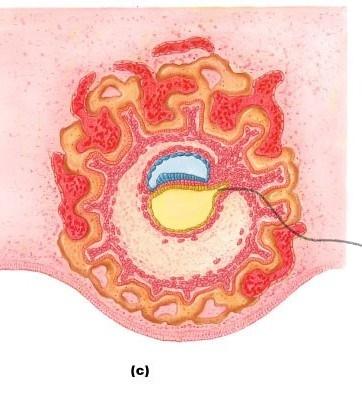 | back 16 allantois |
front 17 Which trimester is for weight gain | back 17 3rd trimester |
front 18 Secondary oocyte completes the first meiotic division | back 18 at the time of ovulation |
front 19 The second polar body forms from the secondary oocyte | back 19 after fertilization by sperm cell |
front 20 the 16 or more cell stage (72 hours old) | back 20 morula |
front 21 the cell layer which looses their plasma membranes and invade the endometrium is | back 21 syncitiotrophoblast |
front 22 placenta forms from | back 22 embryonic trophoblasts and maternal endometrium both A and B |
front 23 Teratogenic (leading to structural deformity in newborn) drug such as thalidomide or phenothiazine mostly affect which stage of pregnancy and development | back 23 1st trimester |
front 24 implantation is usually completed after | back 24 the blastocyst is entirely surrounded by endometrium |
front 25 the outermost embryonic membrane is the | back 25 chorion |
front 26 the process which transforms the embryo into a three-layered stage is called | back 26 gastrulation |
front 27 How many weeks does the embryonic period last | back 27 8 weeks |
front 28 epiblast cells on the dorsal surface of embryonic disc form a transparent membrane filled with fluid called | back 28 amnion |
front 29 a small outpocketing at the caudal end of the yolk sac | back 29 allantois |
front 30 organogenesis occurs during | back 30 1st trimester |
front 31 raised edged dorsal groove on early embryonic disc that establishes the longitudinal axis of the embryo is | back 31 primitive streak |
front 32 by the fourth or fifth day the pre-embryo consists of 100 cells called ____ stage | back 32 blastocyst |
front 33 implantation is completed by the ___ day after ovulation | back 33 5th |
front 34 allantois provides structural base for the ____ | back 34 umbilical cord |
front 35 there are ___ pairs of somites | back 35 40 |
front 36 somites have three functional parts | back 36 sclerotome, dermatome, myotome |
front 37 Embryonic development of the digestive system (3rd week) | back 37 endoderm has folded and foregut and hindgut have formed the midgut is open and continuous with the yolk sac mouth and anal openings are nearly formed |
front 38 8th week | back 38 accessory organs are budding from endoderm |
front 39 rooting reflex | back 39 helps infants find the nipple |
front 40 suckling reflex | back 40 aids in swallowing |
front 41 morula | back 41 the 16 or more cells stage (72 hours old). By the fourth or fifth day the pre embryo consists of 100 or so cells |
front 42 ectoderm | back 42 forms structures of the nervous system and skin epidermis |
front 43 endoderm | back 43 forms epithelial linings of the digestive, respiratory and urogenital systems |
front 44 mesoderm | back 44 forms all the other tissues |
front 45 sclerotome | back 45 produce the vertebrae and ribs |
front 46 dermatome | back 46 help form the dermis of the skin on the dorsal part of the body |
front 47 myotome | back 47 form the skeletal muscles of the neck, trunk, and limbs |
front 48 ductus venosus | back 48 venous shunt that by passes the liver |
front 49 foramen ovale | back 49 opening in the interatrial septa to bypass pulmonary circulation |
front 50 the chorionic membrane is formed by which of the following layers in a developing embryo? | back 50 cytotrophoblast and syncitiotrophoblast both B and C |
front 51 the umbilica cords becomes | back 51 ligamentum teres |
front 52 ductus venosus becomes | back 52 ligamentum venosum |
front 53 umbilical arteries becomes | back 53 medial umbilical ligaments |
front 54 the foramen ovale becomes | back 54 fossa ovalis |
front 55 ductus arteriosus becomes | back 55 ligamentum arteriosum |
front 56 vasectomy | back 56 cutting and ligating the ducdtus deferens |
front 57 ejaculation | back 57 propulsion of semen from the male duct system |
front 58 suspensory | back 58 anchors the ovary laterally to the pelvic wall |
front 59 mesovarium | back 59 suspends the ovary in between |
front 60 broad ligament | back 60 contains the suspensory ligament and mesovarium |
front 61 mittelschmerz | back 61 a twinge of pain sometimes felt at ovulation |
front 62 Days 1-5 | back 62 menstrual phase. uterus sheds all but the deepest part of the endometrium |
front 63 days 6-14 | back 63 proliferative (preovulatory) phase. endometrium rebuilds itself |
front 64 Days 15-28 | back 64 secretory (postovulatory) phase. endometrium prepares for implantation of the embryo |
front 65 implantation of a blastocyst inner cell mass trophoblast blastocyst activity syncytiotrophoblast cytotrophoblast | back 65 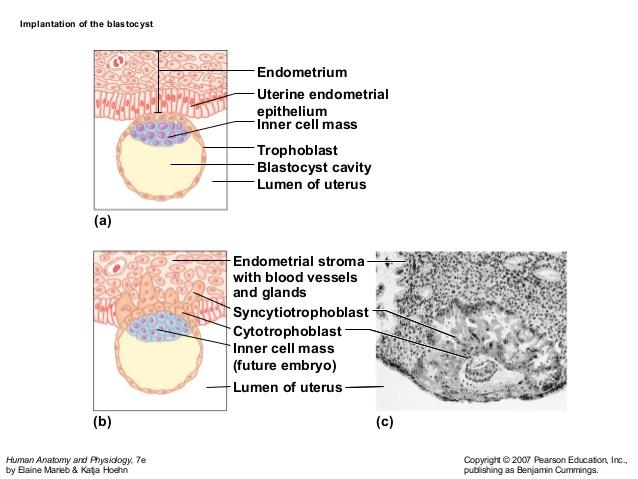 |
front 66 hormonal changes during pregnancy hCG estrogen pregesterone | back 66 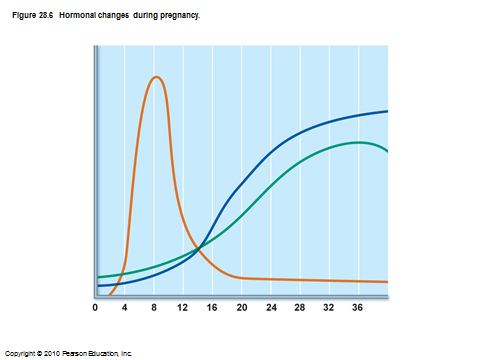 |
front 67 events of placentation | back 67  |
front 68 circulation in fetus and newborn | back 68 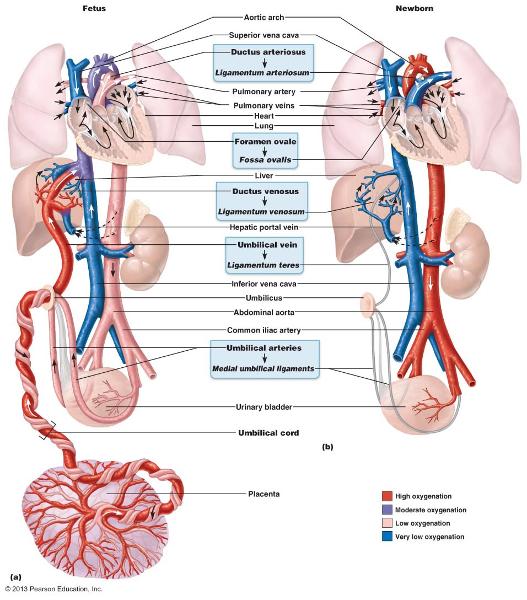 |
front 69 chadwick's signs | back 69 the female reproductive organs become increasingly vascular and engorged with blood, and the vagina develops a purplish hue |
front 70 relaxin | back 70 causes pelvic ligaments and pubic symphysis to relax, widen, and becomes more flexible |
front 71 stages of labor | back 71 dilation stage expulsion stage placental stage |
front 72 dilation stage | back 72 time from labor's onset until the cervix is fully dilated by the baby's head ( about 10cm in diameter). last about 6-12 hours or more. |
front 73 expulsion stage | back 73 lasts from full dilation to delivery of the infant or actual birth |
front 74 placental stage | back 74 delivery of the placenta |
front 75 engagement | back 75 occurs when the infant's head enters the true pelvis |
front 76 crowning | back 76 occurs when the largest dimension of the baby's head distends the vulva |